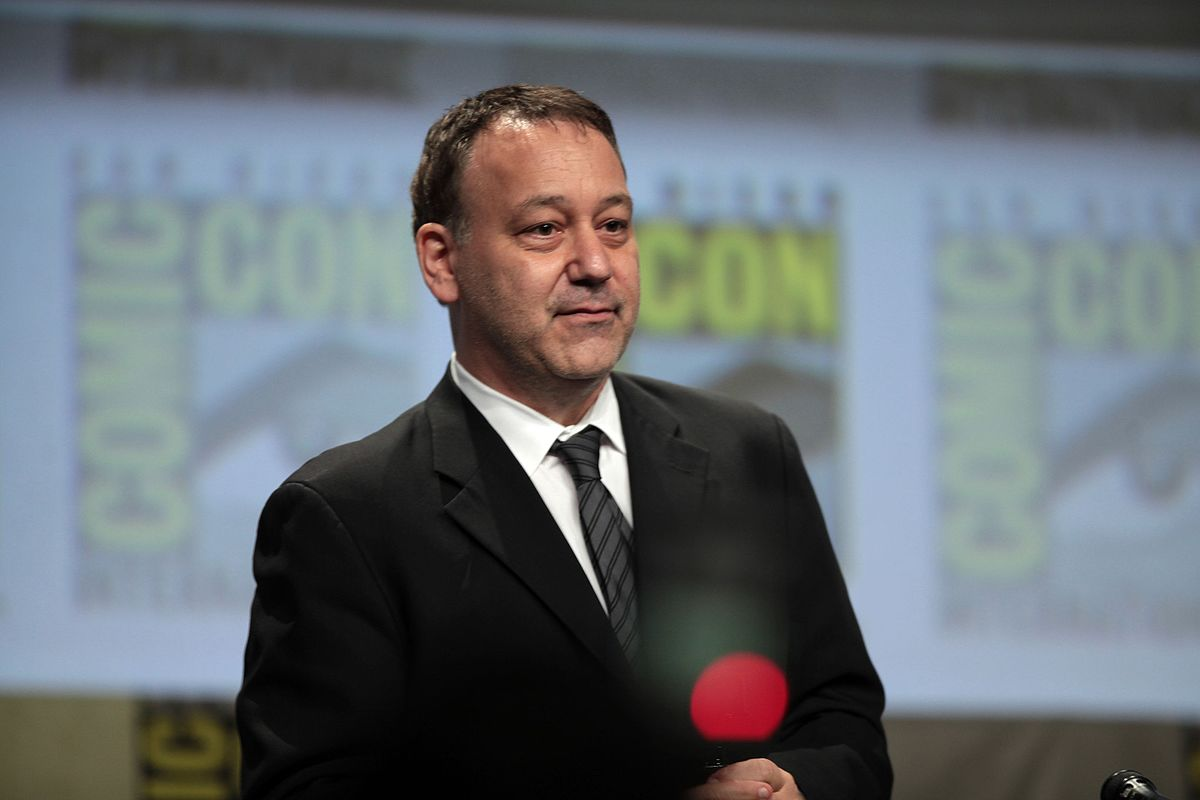Title of the work
Studio / Production Company
Country of the First Edition
Country/countries of popularity
Original Language
First Edition Date
First Edition Details
Hercules in the Underworld. Directed by Bill Norton; written by Christian Williams, Andrew Dettmann, and Daniel Truly. USA, (Universal) Action Pack Weds 8–10pm (syndicated television); 7 November 1994. 90 mins.
Running time
Format
Date of the First DVD or VHS
Genre
Action and adventure fiction
B films
Mythological fiction
Television series
Target Audience
Crossover
Cover

We are still trying to obtain permission for posting the original cover.
Author of the Entry:
Joel Gordon, University of Otago, joel_gordon@hotmail.co.nz
Peer-reviewer of the Entry:
Elizabeth Hale, University of New England, ehale@une.edu.au
Elzbieta Olechowska, University of Warsaw, elzbieta.olechowska@gmail.com

Sam Raimi by Gage Skidmore. Retrieved from Wikimedia Commons, licensed under CCBY-SA 2.0 (accessed: December 30, 2021).
Sam Raimi
, b. 1959
(Producer)
Sam Raimi is an American filmmaker, actor and producer. He was born in Michigan (USA), to a conservative Jewish family, and attended Michigan State University. His career has been closely linked with that of Robert Tapert. Although Raimi intended to major in English, he chose to put his studies on hold in order to work on the feature film The Evil Dead (1981), after the success of his first co-operative production with Robert Tapert, The Happy Valley Kid (1977). Raimi is a co-founder of both Renaissance Pictures and Ghost House Pictures (see above). His solo-directorial work (distinct from productions with Tapert) include the original Spider-man trilogy (2002–2007) starring Tobey Macquire, and, most recently, Oz the Great and Powerful (2013). His most recent solo-producer role was for the crime-thriller, Don’t Breathe (2016). As an actor, Raimi has appeared in many of his own films as minor characters – such as his cameo appearances in The Evil Dead and its sequels. Raimi turned to television during the 1990’s, working together with Tapert as a producer for the franchises Hercules: The Legendary Journeys, Xena: Warrior Princess, Young Hercules and Spartacus.
Bio prepared by Joel Gordon, University of Otago, joel_gordon@hotmail.co.nz

Robert Tapert by Cooltv. Retrieved from Wikipedia, licensed under CC0 (accessed: December 30, 2021).
Robert Tapert
, b. 1955
(Author, Producer)
Robert Tapert is an American actor, producer and writer. Born in Royal Oak, Michigan (USA), he attended Michigan State University where he first began experimenting with filmmaking under the influence of Sam Raimi. During this time, they both worked on the film The Happy Valley Kid (1977) in which Tapert also starred in the leading role. Following the success of this venture, the pair began work on their first feature film, The Evil Dead (1981) – directed by Sam Raimi and starring Bruce Campbell – and, in order to assist with its production, Tapert, Raimi and Campbell (along with Irvin Shapiro) co-founded Renaissance Pictures in 1979. This trio have since worked together on numerous successful films – particularly in the horror genre – including: Crimewave (1985), Easy Wheels (1989), Darkman (1990), Lunatics: A Love Story (1991), Timecop (1994), 30 Days of Night (2007) and The Gift (2015). In 2002 Tapert and Raimi co-founded Ghost House Pictures known for, among others, the film franchises The Grudge (2004, 2006, 2009) and Bogeyman (2005, 2007, 2008). Tapert’s involvement in television began during the 1990’s with his most notable productions being the franchises of Hercules: The Legendary Journeys (1995-1999), Xena: Warrior Princess (1995–2001) and Young Hercules (1998–1999) – all of which included both direct-to-television movies and television serials spanning several seasons. It was during this period – in 1998 – that Tapert married New Zealand actress Lucy Lawless (the star of Xena), with whom he has since had two children. More recently, his interest in antiquity and television has returned with the serials Spartacus: Blood and Sand (2010), Spartacus: Gods of the Arena (2011), Spartacus: Vengeance (2012) and Spartacus: War of the Damned (2013) and plans for a Xena reboot for NBC. (see further, his official website, accessed: August 16, 2019).
Bio prepared by Joel Gordon, University of Otago, joel_gordon@hotmail.co.nz

Christian Williams by Pacunagonz. Retrieved from Wikimedia Commons, licensed under CC BY-SA 4.0 (accessed: December 30, 2021).
Christian Williams
, b. 1943
(Author, Producer)
Christian Williams is an American journalist and television writer from Brooklyn, New York. His career in the news industry began in 1972 as an assistant editor (Style Section) for The Washington Post. It was during his early years at the Post that Williams was given a unique insight into the film/television industry, serving as the editor on a behind-the-scenes exclusive when Robert Redford used the Post’s newsroom to research his film All the President’s Men (1976). In 1984 Williams became a reporter in Bob Woodward’s investigative team which led to his second interaction with the film/television industry: in 1986 Woodward’s team (Woodward, Williams and co-journalist Richard Harwood) wrote and featured in an ABC movie, Under Siege, which was based upon the group’s reporting on domestic terrorism. Williams then continued to dabble in the television industry, co-writing (alongside Woodward) an episode of the television drama series Hill Street Blues (1981–1987), before formally leaving journalism for a career as a television writer – specializing in one-hour drama television shows. He went on to co-create (alongside David Milch) the drama Capital News (1990) before assisting in the creation of Hercules: The Legendary Journeys franchise (which began with the five direct-to-television films). Unlike Tapert and Raimi, however, Williams was not directly involved in the production of the Hercules: The Legendary Journeys serial beyond the pilot films. Williams went on to continue writing for television, for example as the co-executive producer of the drama Six Feet Under (2001–2005), until he retired in 2010. He has since turned his interests to authoring books and sailing.
Bio prepared by Joel Gordon, University of Otago, joel_gordon@hotmail.co.nz
Casting
Hercules: Kevin Sorbo,
Zeus: Anthony Quinn,
Deianeira: Tawny Kitaen,
Iole: Marley Shelton,
Nessus: Cliff Curtis,
Eryx the Boxer: Jorge Gonzáles,
Hades: Mark Ferguson,
Charon: Michael Hurst.
Adaptations
Cf. overall series entry.
Sequels, Prequels and Spin-offs
Cf. overall series entry.
Summary
This narrative is based loosely on a combination of several known mythological tales: the rape of Deianeira by Nessus, the labour of Hercules capturing Cerberus in the underworld, the death of Hercules and Orpheus’ catabasis. The film begins in an undisclosed village where the ground opens up to create an eerie fissure from out of which a strange green light and mist emerge, destroying all who come into contact with it. Meanwhile, in Hercules’ own village, the hero is forced out of “retirement” to deal with Eryx the boxer – a villainous figure who has been conning (and killing) the villagers. Upon slaying Eryx, Hercules is presented with a peacock feather – a symbol of Hera – by Eryx’s handler. Hercules grows angry at Hera’s trials and at the needless loss of life, confronting the goddess and destroying her nearby shrine when she refuses to relent.
The next day a beautiful maiden arrives at Hercules’ house and collapses. She identifies herself as Iole and asks Hercules to rescue her village which is plagued by the unnatural fissure. Meanwhile, the centaur Nessus has become jealous of all the praise that Hercules is receiving. When Hercules, Nessus and Iole leave on their quest, Iole gives a medallion to Deianeira as a gift – revealed to be a symbol of a Nurian maiden: young women trained in the art of convincing men to perform any task for them. Deianeira chases after Hercules, hoping to reach him before the maiden can woo him, but it turns out that the hero knew the truth all along and was on his guard. Hercules instructs Nessus to take Deianeira home, only for the centaur to try and abduct his charge. Hercules saves Deianeira by slaying the centaur with an arrow, but not before Nessus gives his blood-soaked cloak to Deianeira, promising her that should Hercules wear it, he would remain faithful to her forever.
Upon reaching the fissure, Zeus reveals to Hercules that it leads to the underworld. Hercules then enquires whether he is a mortal or immortal, but the god refuses to answer. Hercules is convinced there is nothing he can do to save the town and resolves to return home. But, as it is a cold night, Hercules puts on Nessus’ cloak which springs to life, strangling him. Seeking relief from the torment, Hercules leaps into the fissure. Upon arriving at the bottom, Hercules encounters Charon who is unwilling to give Hercules passage across the Styx until the hero bullies him. Meanwhile, Deianeira is informed of Hercules fate and is tricked into walking off a cliff by Hera. Back in the underworld, Hercules fights numerous monsters including a mob of the various enemies whom he had previously killed. Hercules then encounters Nessus who informs him that the cloak was Hera’s doing and that Deianeira is now dead. Hercules tricks Nessus into showing him Deianeira via a portal, through which the hero jumps, finding himself in the Elysian fields. Hades informs Hercules that Deianeira does not remember anything about her life but the pair make a deal that Deianeira will be restored to Hercules if the hero is able to capture Cerberus (who has escaped his post guarding the entrance to the underworld). After a long chase, Hercules finds Cerberus and is able to return him to his post via gentle persuasion rather than brute force. With the entrance to the underworld now restored, the fissure seals itself and Hercules and Deianeira are returned to the upper world and their life together.
Analysis
Hercules in the Underworld returns to the style of story-telling/adaptation found within the first movie, Hercules and the Amazon Women, as the plot takes the majority of its narrative inspiration from one of the myths of Hercules’ labour: here, the labour of capturing Cerberus from the underworld. This myth was well known during antiquity with representations of the narrative occurring in a variety of genres and forms: literary, e.g. the mythographers Apollodorus (Bibl. 2.5.12) and Diodorus Siculus (4.25.1, 4.26.1); dramatic, e.g. Aristophanes Frogs and Euripides Heracles; and visually, on numerous Attic and Apulian vases.
Whether consciously or otherwise, the film picks up on several particularly subtle variants of this myth. First, Apollodorus (Bibl. 2.5.12) and a scholium on Homer’s Iliad (apud 5.395–397) record that Hercules made a deal with Hades to capture Cerberus. Indeed, in the film Hercules does exactly this, making a deal with Hades to capture Cerberus and restore order to the underworld; however, in return, Hercules requests Deianeira’s resurrection and in this regard, the film has more in common with the catabasis of Orpheus who undertook a catabasis to seek Eurydice’s return (see, e.g., Diodorus Siculus 4.25.4; Ovid Metamorphoses 10.1-80; Vergil Georgics 4.453–525). Here, however, Hercules is ultimately successful where Orpheus is not. Further, these two ancient sources affirm that a condition of the pact was that Hercules had to tame Cerberus without the use of his weapons. This too is reflected in the film, although Hercules chooses to lay down his arms and ‘embrace’ Cerberus, rather than to fight the beast, and it is for this reason that Hercules is successful when Hades’ own hunters are not. This is, of course, part of the franchises’ interest in presenting a modern (pacifist?) Hercules.
There is one notable point of difference between ancient versions of Hercules’ labour and this film: the motive for the catabasis. In our ancient sources, this is one of Hercules’ famous twelve labours ordered by King Eurystheus. Here, however, there is no mention of any labours, nor the King. Instead the motivation for the catabasis lies with an entirely ‘novel’ quest to save Iole’s town from unnatural fissure (itself part of scheme by Hera to hurt the hero) However, Hercules actually abandons Iole’s quest on account of his commitment to his family – i.e. he does not want to risk his life by visiting the underworld and not being able to return – another recurrent theme for the franchise. Hercules is consequently ‘forced’ into his catabasis due to the cloak of Nessus attacking him, resulting in Hercules falling into the chasm to escape the pain. This motivation, by contrast, does find ancient precedent: the rape of Hercules’ wife, Deianeira by the centaur Nessus – see, e.g. Apollodorus (2.151, 157), Diodorus Siculus (4.38.1), Ovid (Met. 9.101ff), Hyginus (Fab. 34). In antiquity, this narrative culminated in either the death and/or apotheosis of Hercules (e.g. Sophocles. Trachiniae; Ovid Met. 9). But it would make little sense for Hercules to either die or be apotheosized at the start of a popular serial franchise. In a manner of thinking, however, Hercules can be said to die simply by partaking in a catabasis. This conceptualization of a catabasis (as equating to one’s death) finds precedent in Homer’s Odyssey for Circe greets Odysseus upon his return from the underworld as a man who will now die twice (Od. 11–12).
In a clever bit of narrative adaptation, it is the figure of Iole who unites the otherwise disparate narratives of Hercules death and his catabasis. In myth, Iole was a captive of Oechalia whom Hercules fell in love with and of whom Deianeira became jealous (see, e.g., Diodorus Siculus 4.38.1; Ovid Heroides 9). It is because of this jealousy that Deianeira gives Hercules the cloak of Nessus, believing it to be a love potion. But Iole never appears in conjunction with Hercules’ catabasis. In the film, however, the essence of Iole’s characterisation is retained as Deianeira indeed becomes jealous of her and for this reason gives the cloak as a ‘love potion’ but this is because Iole is a beautiful and alluring Nurian maiden (an innovation by the film). Thus, by attributing to Iole the quest which results in Hercules catabasis, these two narratives become united.
Further Reading
Cf. overall series entry.
Addenda
Directors: Bill Norton.
Writers: Andrew Dettmann and Daniel Truly.


